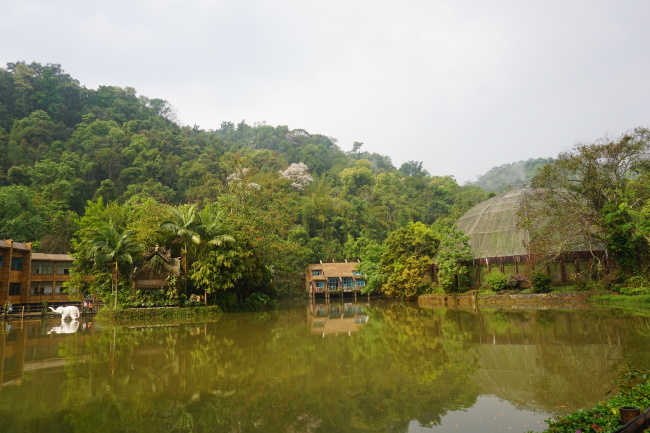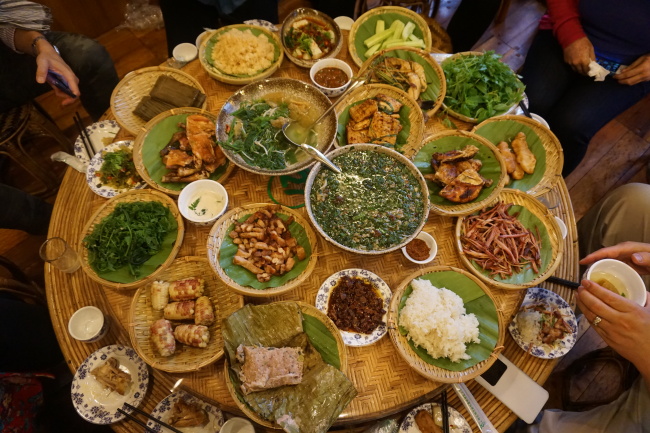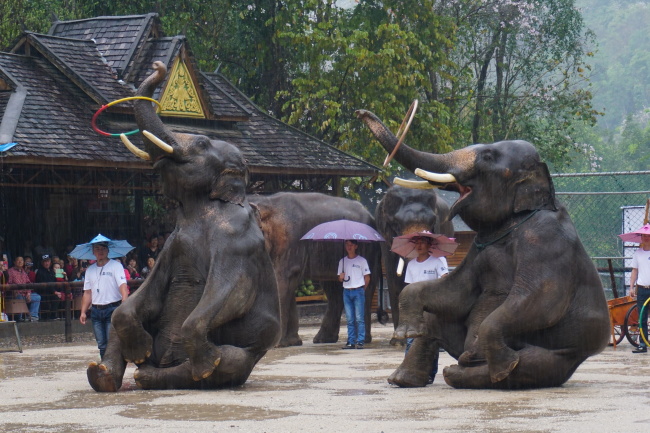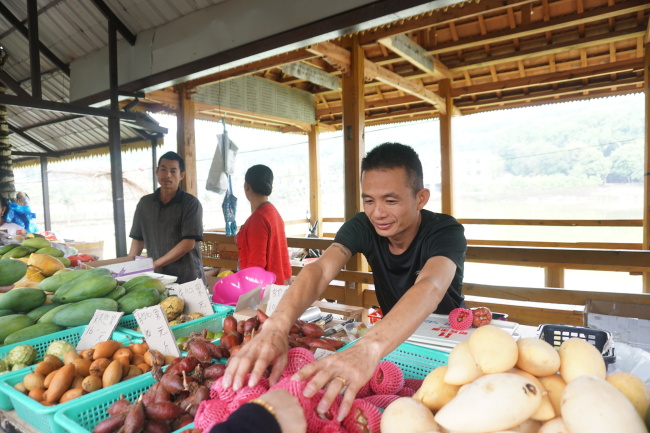XISHUANGBANNA, China ― Xishuangbanna is not “typical” China.
Located at the very southern end of Yunnan province and dubbed China’s mini-Thailand, it strikes visitors as remarkably Southeast Asian.
The region’s capital city, Jinghong, lies close to the border with Laos and Myanmar. The palm tree-lined streets, jungle-capped mountains and tropical climate are all proof that this is where China meets Southeast Asia.
The lengthy name Xishuangbanna is lesser known to people ― even in China ― and never made news headlines until very recently, when Britain’s Prince William visited the region as the final stop on his China tour in March.
 |
View of the Wild Elephant Valley |
The prince had one clear purpose to head south: the Wild Elephant Valley, a safe haven for endangered Asian elephants. Feeding carrots to a rescued elephant named Ran Ran, he voiced concerns for endangered animals and raised the issue of illegal wildlife trade.
Aside from the mammals, however, the region is home to many notable things from premium-quality Pu-erh tea and a tropical spread of rainforests with picturesque hiking trails to the indigenous Dai minority group who make up one-third of the region’s 1 million people.
 |
Traditional Dai cuisine at the Manfeilong Grilled Chicken restaurant |
In the past, the rugged terrain and cloud-veiled mountains of Xishuangbanna had kept people from other regions from frequent visits. Now with improved air and ground transportation, it is emerging as a greener, fresher and sunnier vacation destination for Chinese travelers. International hotels are on the rise.
Xishuangbanna is not spread out in a tourist-friendly style, and a big part of the joy of traveling the area is the search for and appreciation of the real gems of the area.
Wild Elephant Valley
Every day, thousands of visitors make a pilgrimage to the jungle located an hour’s drive north from Jinghong. The Wild Elephant Valley, which spans nearly 3.7 square kilometers, is home to about 150 wild Asian elephants.
“Elephants don’t come out when there are too many people around,” said Xu Ping, a tour guide at the park. “Usually, the families of elephants roam around early in the morning and late at night to drink water.”
There are wooden viewing platforms for the visitors to observe the elephants from, but one has to be very lucky to spot one.
 |
Elephant circus at the Wild Elephant Valley |
For those unfortunate visitors who fail to catch a glimpse of the shy herds of the valley, there is an elephant circus twice a day. Titled “Elephant School,” the trained elephants kick soccer balls and dance to music, as spectators packing three corners of the arena clap and take pictures.
The show is most likely to be the only encounter with the elephants for most visitors to the park, but the rain forest offers a slew of other features such as a butterfly park, a peacock garden and a bird aviary. Its 1-kilometer-long trail is a pleasant, scenic walk through the reassuringly familiar and genuinely exotic forest, alongside a gentle river valley.
Traditional Dai villages
There are 1.2 million ethnic Dai people in the world, and most of them reside in Xishuangbanna. The Dai prevalence in the area is palpable, with the streets embedded with colorful traces of Dai tradition, including Dai-style temples, Buddhist pagodas and bamboo bridges.
Mandiu Village, home to some 400 people, is open for tours to fully immerse visitors with the Dai culture and customs.
With more than 1,000 years of history, the humble village is populated by two-story bamboo houses, brick walls, opulent palm trees and roaming chickens. Every morning, a street market opens against the backdrop of a pond, which sets the village apart from other neighborhoods.
The villagers stand behind the rusty market stalls and sell everything from homespun goods to grilled chicken skewers, fresh mangoes, noodle soup and steamed sticky rice stuffed inside bamboo sticks, a breakfast staple for the Dai people.
Real, succulent Dai food, which can be characterized as sour, hot and crisp, is sold at the market for cheaper prices than at regular restaurants in the city.
 |
The street market at the Mandiu Village |
For a full Dai dining experience, which to some can taste similar to Thai food, grab a table at Manfeilong Grilled Chicken. A small round table is covered with at least 20 dishes, including Dai-style roasted chicken, pineapple rice, fried flavored tofu stuffed with minced pork, cilantro-covered soup and fried bananas.
The restaurant is located inside the Gaozhuang Xishuangjing area, which means “nine towers and 12 villages” in the local Dai language. The area is a replica of an ancient Jinghong city, and there are many restaurants and outlets along the street to walk by.
After dinner, you can watch the famous performance “Shui Wu Yuan” (Beautiful South Performance) at the Xishuangbanna Grand Mountain Forest Theater, which is in walking distance from the restaurant. The two-hour-long water-themed songs and dances delve into Dai history and culture.
Also, the atmospheric Starlight Night Market is open until 11 p.m., for late-night snacks of smelly tofu or lamb skewers, or last-minute shopping for Dai traditional clothes.
Water Splash Festival
Go to Xishuangbanna in mid-April to get the full experience of its famous Water Splash Festival, which marks the New Year of the Dai calendar. The festival is very similar to Thailand’s Songkran festival, where everyone gets soaked.
For the first day, people put on their nicest clothes and gather with their family at the local Dai temples to bathe the Buddha statue with water. After the sacred ritual, people can sprinkle each other with cold water, a sign of blessing and respect.
Beside endless water fights with water guns and buckets, the music, dance and flavorful Dai cuisine add to the festivities.
Where to stay
The newly opened Sheraton Xishuangbanna is where world-class hospitality meets the local culture. Nestled only 10 minutes’ drive from the Xishuangbanna Gasa Airport, the newest international chain boasts comfort with a hint of Dai flavor.
“Xishuangbanna is very native, different from primary and secondary (Chinese) cities that are big,” Vincent Ong, senior director of brand management for Sheraton in the Asia-Pacific region, told The Korea Herald. “It has its own charms, lots of attractions and there are many different ethnic groups. The physical location of (Xishuangbanna) has a great temperature, cool in the evenings and not too hot during the day. We found a nice location.”
The 361-room hotel visually reflects the rich Dai culture, with a wood-carved wall mural of peacock tails ― a revered animal of the Dai people ― in the lobby, and lighting that resembles the leg of an elephant, the Dai people’s favorite animal. The two wings of the hotel are even named after the peacock and elephant.
By Ahn Sung-mi, Korea Herald correspondent (
sahn@heraldcorp.com)











